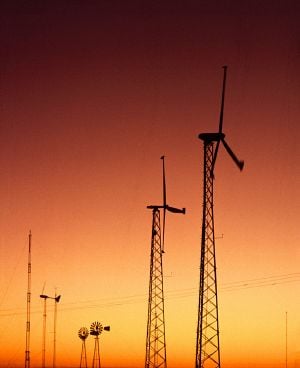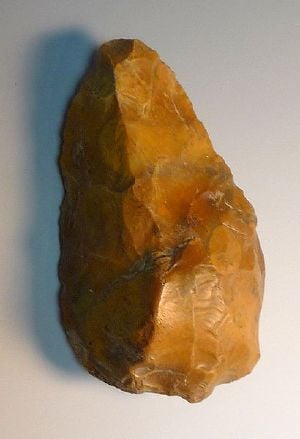Machine
- This article is about devices that perform tasks.
The scientific definition of a machine is any device that transmits or modifies energy. In common usage, the meaning is restricted to devices having rigid moving parts that perform or assist in performing some work. Machines normally require some energy source ("input") and always accomplish some sort of work ("output"). Devices with no rigid moving parts are commonly considered tools, or simply devices, not machines.
People have used mechanisms to amplify their abilities since before written records were available. Generally these devices decrease the amount of force required to do a given amount of work, alter the direction of the force, or transform one form of motion or energy into another.
Modern power tools, automated machine tools, and human-operated power machinery are tools that are also machines. Machines used to transform heat or other energy into mechanical energy are known as engines.
Hydraulics devices may also be used to support industrial applications, although devices entirely lacking rigid moving parts are not commonly considered machines. Hydraulics are widely used in heavy equipment industries, automobile industries, marine industries, aeronautical industries, construction equipment industries, and earthmoving equipment industries.
History
Perhaps the first example of a human made device designed to manage power is the hand axe, made by chipping flint to form a wedge. A wedge is a simple machine that transforms lateral force and movement of the tool into a transverse splitting force and movement of the workpiece.
The idea of a simple machine originated with the Greek philosopher Archimedes around the third century B.C.E., who studied the Archimedean simple machines: lever, pulley, and screw. However the Greeks' understanding was limited to statics (the balance of forces) and did not include dynamics (the tradeoff between force and distance) or the concept of work.
During the Renaissance the dynamics of the Mechanical Powers, as the simple machines were called, began to be studied from the standpoint of how much useful work they could perform, leading eventually to the new concept of mechanical work. In 1586 Flemish engineer Simon Stevin derived the mechanical advantage of the inclined plane, and it was included with the other simple machines. The complete dynamic theory of simple machines was worked out by Italian scientist Galileo Galilei in 1600 in Le Meccaniche ("On Mechanics"). He was the first to understand that simple machines do not create energy, they merely transform it.
The classic rules of sliding friction in machines were discovered by Leonardo da Vinci (1452–1519), but remained unpublished in his notebooks. They were rediscovered by Guillaume Amontons (1699) and were further developed by Charles-Augustin de Coulomb (1785).
Mechanical advantage and efficiency
The mechanical advantage of a simple machine is the ratio between the force it exerts on the load and the input force applied. This does not entirely describe the machine's performance, as force is required to overcome friction as well. The mechanical efficiency of a machine is the ratio of the actual mechanical advantage (AMA) to the ideal mechanical advantage (IMA). Functioning physical machines are always less than 100 percent efficient.
Types
Mechanical
The word mechanical refers to the work that has been produced by machines or the machinery. It mostly relates to the machinery tools and the mechanical applications of science. Some of its synonyms are automatic and mechanic.
Simple machines
The idea that a machine can be broken down into simple movable elements led Archimedes to define the lever, pulley and screw as simple machines. By the time of the Renaissance this list increased to include the wheel and axle, wedge and inclined plane.
Engines
An engine or motor is a machine designed to convert energy into useful mechanical motion.[2][3] Heat engines, including internal combustion engines and external combustion engines (such as steam engines) burn a fuel to create heat, which is then used to create motion. Electric motors convert electrical energy into mechanical motion, pneumatic motors use compressed air and others, such as wind-up toys use elastic energy. In biological systems, molecular motors like myosins in muscles use chemical energy to create motion.
Electrical
Electrical means operating by or producing electricity, relating to or concerned with electricity. In other words, it means using, providing, producing, transmitting or operated by electricity.
Electrical machine
An electrical machine is the generic name for a device that converts mechanical energy to electrical energy, converts electrical energy to mechanical energy, or changes alternating current from one voltage level to a different voltage level.
Electronic machine
Electronics is the branch of physics, engineering and technology dealing with electrical circuits that involve active electrical components such as vacuum tubes, transistors, diodes and integrated circuits, and associated passive interconnection technologies. The nonlinear behaviour of active components and their ability to control electron flows makes amplification of weak signals possible and is usually applied to information and signal processing. Similarly, the ability of electronic devices to act as switches makes digital information processing possible. Interconnection technologies such as circuit boards, electronic packaging technology, and other varied forms of communication infrastructure complete circuit functionality and transform the mixed components into a working system.
Computing machines
Computers are machines to process information, often in the form of numbers. Charles Babbage designed various machines to tabulate logarithms and other functions in 1837. His Difference engine can be considered an advanced mechanical calculator and his Analytical Engine a forerunner of the modern computer, though none were built in Babbage's lifetime.
Modern computers are electronic ones. They use electric charge, current or magnetization to store and manipulate information. Computer architecture deals with detailed design of computers. There are also simplified models of computers, like State machine and Turing machine.
Molecular machines
Study of the molecules and proteins that are the basis of biological functions has led to the concept of a molecular machine. For example, current models of the operation of the kinesin molecule that transports vesicles inside the cell as well as the myosin molecule that operates against actin to cause muscle contraction; these molecules control movement in response to chemical stimuli.
Researchers in nano-technology are working to construct molecules that perform movement in response to a specific stimulus. In contrast to molecules such as kinesin and myosin, these nanomachines or molecular machines are constructions like traditional machines that are designed to perform in a task.
| Classification | Machine(s) | |
|---|---|---|
| Simple machines | Inclined plane, Wheel and axle, Lever, Pulley, Wedge, Screw | |
| Mechanical components | Axle, Bearings, Belts, Bucket, Fastener, Gear, Key, Link chains, Rack and pinion, Roller chains, Rope, Seals, Spring, Wheel | |
| Clock | Atomic clock, Watch, Pendulum clock, Quartz clock | |
| Compressors and Pumps | Archimedes' screw, Eductor-jet pump, Hydraulic ram, Pump, Trompe, Vacuum pump | |
| Heat engines | External combustion engines | Steam engine, Stirling engine |
| Internal combustion engines | Reciprocating engine, Gas turbine | |
| Heat pumps | Absorption refrigerator, Thermoelectric refrigerator, Regenerative cooling | |
| Linkages | Pantograph, Cam, Peaucellier-Lipkin | |
| Turbine | Gas turbine, Jet engine, Steam turbine, Water turbine, Wind generator, Windmill | |
| Aerofoil | Sail, Wing, Rudder, Flap, Propeller | |
| Information technology | Computer, Calculator, Telecommunications networks | |
| Electricity | Vacuum tube, Transistor, Diode, Resistor, Capacitor, Inductor, Memristor, Semiconductor | |
| Robots | Actuator, Servo, Servomechanism, Stepper motor | |
| Miscellaneous | Vending machine, Wind tunnel, Check weighing machines, Riveting machines | |
ReferencesISBN links support NWE through referral fees
- Boothroyd, Geoffrey and Winston A. Knight. 2005. Fundamentals of Machining and Machine Tools, Third Edition (Mechanical Engineering (Marcell Dekker)). Boca Raton, FL: CRC. ISBN 1574446592
- Myszka, David H. 1998. Machines and Mechanisms: Applied Kinematic Analysis. Upper Saddle River, NJ: Prentice Hall. ISBN 0135979153
- Oberg, Erik, Franklin D. Jones, Holbrook L. Horton, and Henry H. Ryffel. 2000. Machinery's Handbook. New York, NY: Industrial Press Inc. ISBN 0831126353
- Usher, Abbott Payson. A History of Mechanical Inventions. Dover Publications, 2011. ISBN 978-0486255934
| ||||||||||||||||||||||||||
Credits
New World Encyclopedia writers and editors rewrote and completed the Wikipedia article in accordance with New World Encyclopedia standards. This article abides by terms of the Creative Commons CC-by-sa 3.0 License (CC-by-sa), which may be used and disseminated with proper attribution. Credit is due under the terms of this license that can reference both the New World Encyclopedia contributors and the selfless volunteer contributors of the Wikimedia Foundation. To cite this article click here for a list of acceptable citing formats.The history of earlier contributions by wikipedians is accessible to researchers here:
The history of this article since it was imported to New World Encyclopedia:
Note: Some restrictions may apply to use of individual images which are separately licensed.
- ↑ Chambers, Ephraim (1728), Table of Mechanicks, vol. Volume 2, London, England .
- ↑ Motor. Dictionary.reference.com. Retrieved 2011-05-09.
- ↑ Dictionary.com: (World heritage) "3. any device that converts another form of energy into mechanical energy to produce motion"

